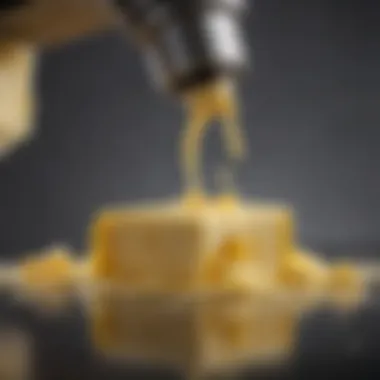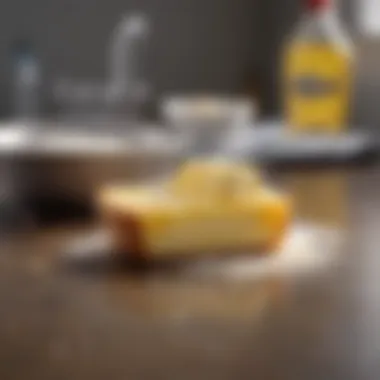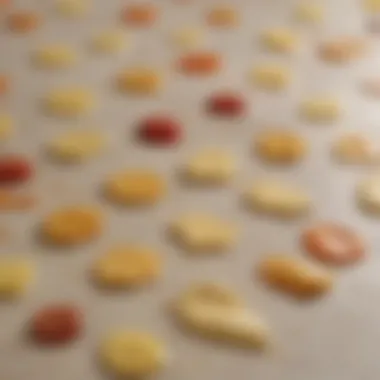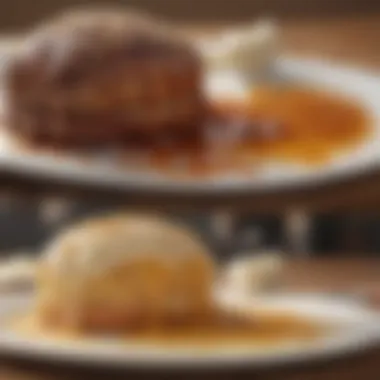A Concise Guide to Removing Butter Stains from Clothes


Intro
Butter stains can often seem like a permanent fixture on your clothing. Their oil-based composition makes them particularly difficult to remove, but with some understanding of the chemistry involved, you can effectively tackle them. This article aims to provide a thorough guide on how to remove butter stains from your garments using common household items along with the right laundering techniques.
You will learn about practical approaches to stain removal, understand the distinctive behavior of butter stains on different fabric types, and consider preventative measures for future incidents. By the end of this guide, you will be well-equipped to restore your clothes to their original condition without the frustration typically associated with stubborn stains.
Understanding Butter Stains
To tackle butter stains effectively, it is essential to understand their nature. Butter consists of fats and oils, making it particularly challenging to remove once it is in fabric. The initial stage of managing food stains lies in comprehension. Knowing the composition and behavior of the item in question is vital for selecting the correct treatment method.
Butter is not only a common ingredient in cooking but also a frequent component of meals enjoyed by many. It is often used in sauces or spread directly onto food. Consequently, the risk of it landing on clothing is high, making understanding butter stains a practical necessity.
The Composition of Butter
Butter primarily comprises water, fat, and small quantities of proteins and carbohydrates. The fats in butter are predominantly saturated fats, which contribute significantly to its consistency and stickiness. When butter touches a piece of clothing, the oily nature can seep into the fabric fibers, establishing a stain that is often stubborn.
The quality and type of butter also factor into stain removal processes. For instance, salted butter contains additional components that may solidify under certain conditions, potentially worsening the stain’s appearance. Understanding these characteristics allows you to better anticipate the needed response when facing a butter stain.
Why Butter Stains Are Difficult to Remove
Butter stains present a unique challenge. The oil-based nature of butter creates a bond with fabric that is not easily broken. Unlike some water-soluble stains, butter requires a different strategy for effective removal. One must also consider the drying process; once butter dries, the oil can become even more absorbed into the fabric, complicating removal efforts.
Several factors contribute to the difficulty in removing butter stains:
- Oil Penetration: The oil in butter penetrates deep into the fabric fibers.
- Heat Sensitivity: Heat can melt the fats, potentially spreading the stain further.
- Challenging Fabrics: Certain fabrics, like silk or delicate wool, react differently to cleaning efforts and may require additional care.
Proper stain management is crucial, as delayed action can turn a mild inconvenience into a permanent blemish on your favorite garments.
Immediate Response to Butter Stains
Reacting promptly to butter stains is crucial. Once butter lands on fabric, it begins to seep in almost immediately. This means that a quick response can significantly increase the chances of complete removal. Inadequate or delayed action may lead to permanent stains, which can be frustrating for any garment owner. Thus, understanding the necessity of immediate response is the first step in stain management.
Assessing the Stain
When faced with a butter stain, the first action should be to assess the extent of the stain. Check how much butter has affected the fabric. A larger stain may require more extensive treatment. Determine the fabric type, as this will guide appropriate cleaning methods. It's important to think about two key factors: the size of the stain and the fabric care instructions. Ignoring the fabric's nature might lead to further damage when using unsuitable cleaning methods.
In a practical sense, you might want to test a small, concealed area of the garment with any cleaning solution you consider. This helps ensure no discoloration or damage occurs from the cleaning process itself.
Acting Quickly: Initial Steps
After assessing, the next step is to act quickly. The first thing to do is to blot the stain gently with a clean cloth or paper towel. Blotting absorbs excess butter, preventing it from spreading. Avoid rubbing, as it could push the butter deeper into the fibers.
Next, gather common household items ready for the next steps. Sometimes, even simple products like cornstarch can help absorb grease. Sprinkle it over the stain and let it sit for a few minutes before gently brushing it off. This initial action can greatly reduce the stain’s intensity before proceeding to specific cleaning methods.
"A prompt response can save your favorite shirt from becoming just another casualty of a kitchen mishap."
Understanding these steps can empower you to tackle butter stains effectively. Each minute spent deliberating can lead to complications. Therefore, swift action is recommended to mitigate damage. Taking the right steps immediately can guide you toward full stain removal.


Materials for Stain Removal
In addressing butter stains, the choice of materials is pivotal. Using suitable items can make a marked difference in stain removal efficiency. Correct materials streamline the process, prevent fabric damage, and may minimize repeat laundry cycles. Selecting the right agents—be it from your pantry or store—can ensure successful outcomes when tackling stubborn butter marks.
It is essential to understand that butter has an oily composition, which complicates its removal. Therefore, materials that possess appropriate properties—like absorbency and solvent action—should be prioritized.
Common Household Items
Common household items provide a convenient first line of defense against butter stains. These materials are often effective and readily accessible, making them practical for immediate use.
- Baking Soda: This item is a staple in many kitchens. Its absorbent quality makes it great for lifting grease from fabrics. You can sprinkle baking soda on the stained area and leave it for a few minutes before brushing it off.
- Cornstarch: Like baking soda, cornstarch absorbs excess oil effectively. Apply it to the stain and let it sit. After a while, shake or brush it away to remove some of the grease.
- Dish Soap: Dish soap, especially those designed for removing grease, can be very effective. A small amount mixed with warm water can help break down the oil in the butter.
- White Vinegar: This household item can aid in dissolving oil stains. Mixing vinegar with water creates a solution that can be applied directly to the stain.
These items are not only effective but also economical and safe for use on many fabrics. Always check first if the fabric can handle the non-conventional treatment.
Commercial Stain Removers
In certain situations, relying on commercial products may yield better results. These products are specifically formulated for tough stains, including butter. Below are a few considerations about commercial stain removers:
- Specialized Formulas: Many products are designed for specific stain types, ensuring a targeted approach. Look for products labeled as suitable for grease and oil stains.
- Brand Reputation: Established brands often have a proven track record. Products like OxiClean MaxForce and Zout are beneficial for grease stains.
- Ease of Use: Most commercial stain removers come with clear instructions. They offer precise application methods which may simplify the removal process.
- Pre-treatment: Before laundering, using a commercial stain remover can enhance cleaning outcome. Apply it directly to the stain and let it sit for a short time as directed by the manufacturer.
"A proactive approach to stain management not only saves time but also maintains the integrity of your favorite garments."
For further information on various stain removers, visit Wikipedia or check customer reviews on platforms like Reddit for personal experiences with specific products.
Step-by-Step Guide to Removing Butter Stains
Removing butter stains requires a systematic approach. This section explains a methodical sequence of actions that ensures effectiveness. Each step is critical because immediate attention to the stain helps prevent it from setting in. Using the right materials and techniques can lead to successful removal without damaging the fabric. Familiarizing oneself with this process provides invaluable skills for maintaining garments.
Step One: Blotting the Stain
The first action when encountering a butter stain is blotting. Blotting is essential because it helps absorb excess butter, limiting its spread. Use a clean cloth or paper towel. Gently press down on the stain without rubbing. Rubbing may push the butter deeper into the fabric fibers, making it harder to remove. The goal here is to lift the stain, not smear it further.
- Choose a blotting tool like a paper towel or cloth.
- Place it over the stain and press gently.
- Keep blotting until no more butter transfers to the cloth.
This initial response makes a significant difference in the stain's removal process.
Step Two: Applying Absorbent Materials
After blotting, apply absorbent materials to further eliminate the remaining oil. Cornstarch or talcum powder can be effective. These substances draw out oil from the fabric. Here’s a brief guide:
- Sprinkle cornstarch or powder generously over the stained area.
- Let it sit for about 15 minutes to allow absorption.
- Once the time is up, gently brush off the powder. A soft brush works best for this task.
Utilizing absorbent materials can significantly reduce the amount of butter left in the fabric, setting the stage for the next step.
Step Three: Using Dish Soap
Dish soap is a powerful ally in the removal of oil-based stains, including butter. Using dish soap functions on the principle of breaking down greasy substances. Here’s how to apply it:


- Prepare a mixture of warm water and a few drops of liquid dish soap. Choose a mild formula to prevent damage.
- Using a clean cloth, apply the soapy solution onto the stain. Do not oversaturate the fabric; a small amount is sufficient.
- Gently work the solution into the stain in a circular motion.
- Let it sit for about 5-10 minutes.
Rinsing thoroughly afterward is crucial to remove soap residues. The mixture helps breakdown the oils, resulting in easier stain removal.
Step Four: Laundering the Garment
The final step is laundering the garment. Proper laundering ensures the complete removal of any leftover stain remnants. Follow these steps:
- Check the garment care label for specific instructions.
- Wash the stained item using the warmest water safe for the fabric.
- Before drying, inspect the area to confirm the stain is gone. If it remains, repeat the previous steps before drying—heat can set the stain permanently.
By laundering correctly, you maximize the chances of returning the garment to its original state. Remember, promptness is essential in this process.
"Acting quickly is crucial in reducing the chance of setting stains into the fabric."
This step-by-step guide provides a comprehensive and effective approach to removing butter stains, giving readers the tools they need to tackle such issues with confidence.
Different Fabric Types and Their Care
Understanding the specific care needs of various fabrics is vital when tackling butter stains. Each fabric type reacts differently to stain removal techniques, making it essential to approach each material with tailored strategies. This section highlights the unique aspects of cotton, wool, silk, and synthetic fabrics, providing insights into their care and considerations during stain removal.
Cotton and Poly-Cotton Blends
Cotton is a popular fabric due to its softness and breathability. When dealing with butter stains on cotton or poly-cotton blends, the approach can be straightforward. The natural fibers allow for effective absorption of both heat and moisture. This means that applying absorbent materials quickly can help lift the stain from the cloth.
To treat a butter stain on cotton:
- Blot immediately: Use a clean cloth to absorb excess butter, preventing it from penetrating deeper into the fibers.
- Use dish soap: Apply a drop of liquid dish soap directly to the stain. Let it sit for a few minutes before rinsing with warm water.
- Wash in warm water: Cotton is generally durable and can withstand a warmer wash cycle.
Wool and Silk Fabrics
Wool and silk are more delicate and require gentle handling. The fibers in these fabrics are sensitive to both heat and harsh chemicals. With butter stains, it's important not to rub the stain, as this can lead to further damage or spreading. Instead, focus on gentle methods.
For wool and silk:
- Immediate blotting: As with cotton, begin by blotting the stain gently with a clean cloth.
- Cold water rinse: Rinse the affected area with cold water to avoid setting the stain.
- Use a specialized cleaner: Consider using a mild detergent designed for delicate fabrics to treat the stain. Always test on a hidden area first.
- Air dry: Avoid using high heat in the drying process, as this could shrink or damage the fabric.
Synthetic Fabrics
Synthetic fabrics, such as polyester and nylon, often resist staining better than natural ones. However, they are not immune to butter stains. These fabrics can typically handle stronger cleaning agents but still require careful attention during the cleaning process.
When working with synthetic fabrics:
- Blot first: Always start by blotting as you would with cotton.
- Use a mixture of water and detergent: Create a solution with warm water and a quality detergent, applying it directly on the stain.
- Machine wash: Synthetic fabrics can usually withstand a regular wash cycle, but check the care label.
Important Note: Always refer to the garment's care label before attempting any stain removal method. Each fabric has unique properties that dictate the appropriate cleaning techniques.
By understanding the characteristics of these fabrics, you can better equip yourself to effectively remove butter stains while preserving the integrity of the material.


Prevention Strategies
Preventing butter stains from occurring in the first place can save time and effort. The strategies employed not only protect garments but also promote a more relaxed dining or cooking experience. Understanding the significance of prevention can change the dynamic of how we interact with food, especially for those who cherish a variety of rich, buttery dishes. Simple changes can lead to significant benefits.
Using Protective Clothing
Wearing proper clothing can act as a first line of defense against butter stains. Aprons are particularly beneficial because they cover a large area of your clothing. Opt for aprons made from easily washable materials. During food preparation, wearing clothing that is not too loose-fitting can also help. Loose attire may unintentionally come into contact with food, increasing the chances of staining. An important consideration is the type of fabric. Choosing synthetic fabrics or blends that resist staining can offer an additional level of protection.
- Durability: Look for aprons that can withstand spills and can be easily cleaned.
- Coverage: Select aprons that provide substantial coverage without compromising comfort.
- Material choice: Prefer machine-washable options, like cotton blends or polyester.
Implementing Safe Eating Practices
Being mindful during meals is another critical factor in preventing butter stains. This can involve several tactics aimed at minimizing risk. For instance, cutting food over a plate can avoid careless spills. Using utensils properly is also essential. This not only enhances dining etiquette but can significantly reduce the chances of messy mishaps. When serving food that contains butter, use caution while pouring or spreading.
- Utensil control: Ensure that knives and spreads are used carefully.
- Eating posture: Maintain a good posture at the table to prevent food from falling.
- Food presentation: Arrange food attractively to reduce the likelihood of overreaching or bumping into plates.
When we adopt preventative measures, we can relish our food without anxiety about inevitable stains. Small actions can collectively lead to a cleaner, stress-free experience.
Implementing these strategies requires minimal effort but yields significant results. When food lovers understand the benefits of prevention, they can enjoy their culinary experiences without the constant worry of potential stains.
When to Seek Professional Help
Removing butter stains from clothes can sometimes be a straightforward task, especially when tackled immediately. However, certain situations may warrant the assistance of professional services. This section explores when it might be necessary to seek professional help, considering the challenges posed by stubborn stains, fabric types, and the consequences of inappropriate stain removal attempts.
Identifying Stubborn Stains
Not all butter stains are created equal. Some may be relatively easy to remove, while others dig into the fabric fibers deeper and resist typical cleaning methods. Identifying stubborn stains is essential. Signs include:
- Discoloration which persists after standard cleaning.
- A greasy residue that remains even after multiple washings.
- Stains that seem to spread rather than lift away.
If you notice these signs, it's advisable to reconsider your approach. The fabric's care label and any previous attempts at removal may influence the decision to consult a professional. Persistent stains may not only affect the garment's appearance but can also lead to further damage if not treated correctly.
Choosing a Reliable Dry Cleaner
Should you decide to seek professional assistance, choosing the right dry cleaner is paramount. Not all cleaners specialize in stain removal, and their methods can vary significantly. Here are some tips to ensure you find a suitable service:
- Research: Look for cleaners with positive reviews regarding stain removal.
- Experience: Inquire about their experience with oily stains like butter. Some may have specific techniques for handling these types of stains.
- Consultation: Many dry cleaners offer free consultations. Take advantage of this to discuss your garment and its stains before proceeding.
- Eco-friendly Options: Consider dry cleaners that use environmentally friendly methods. These approaches can be gentler on fabric, reducing the risk of damage.
- Ask Questions: Don't hesitate to ask about their techniques and success rates with similar stains. A reliable dry cleaner will be transparent about their methods.
Professional help can save your valuable garments from irreversible damage. Seek advice when in doubt about your stain removal skills.
End
In the context of removing butter stains from clothes, concluding effectively underscores the importance of maintaining the integrity of garments through informed methods of stain removal. Understanding the distinct chemistry of butter, combined with practical and immediate strategies, empowers individuals to address stains without extensive long-term damage to fabrics.
Recapping the Essential Points
To effectively tackle butter stains, it is crucial to remember several key steps:
- Blotting the Stain: Always begin by gently blotting the stain to absorb excess butter. Avoid rubbing, as this can spread the stain.
- Utilizing Absorbent Materials: Suggested materials like paper towels or cloth can significantly aid in the initial removal of butter.
- Employing Dish Soap: Leveraging dish soap is a pronounced method due to its grease-cutting ability, which is particularly effective on oil-based stains.
- Laundering Properly: Ensure to follow the specific washing instructions as indicated on garment tags to avoid further damage.
- Checking Different Fabrics: Each fabric type responds differently to stain removal techniques. Hence, knowledge of fabric care is crucial to prevent irreversible damage.
Final Thoughts on Stain Management
Stain management goes beyond just quick fixes. Education on proper care for clothing can help prolong the life of garments, especially for food enthusiasts who often face challenges with various stains. Incorporating preventative measures, such as using protective clothing or adopting careful eating habits, can save time and effort in the long run.
In summary, staying informed about suitable methods and appropriate products will facilitate effective stain removal while protecting the value of your clothing. Engaging with these practical techniques creates a more resilient approach toward even the most stubborn of stains.















